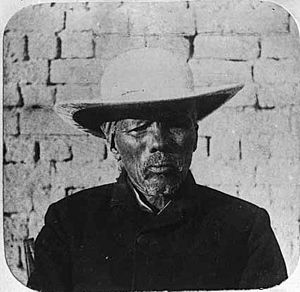Hendrik Witbooi (Namaqua chief) facts for kids
Quick facts for kids
Henrik Witbooi
|
|
|---|---|
 |
|
| Born | 1830 Pella, Northern Cape, Cape Colony
|
| Died | 1905 (aged 74–75) Near Vaalgras
|
| Cause of death | Killed in battle with the Germans |
Hendrik Witbooi (born around 1830 – died October 29, 1905) was an important leader, known as a chief or "Kaptein." He belonged to the ǀKhowesin people, who were part of the larger Nama group.
Witbooi led his people in major fights against German rule in a country now called Namibia. These fights were part of bigger conflicts, including the Herero and Namaqua Wars. He died fighting on October 29, 1905.
Today, Hendrik Witbooi is seen as a national hero in Namibia. His picture is on the front of the N$50, N$100, and N$200 Namibian dollar banknotes.
Contents
Who Was Hendrik Witbooi?
Hendrik Witbooi was also known by his Nama name, ǃNanseb ǀGâbemab. People sometimes called him Kort, which means "short" in Dutch. In the Herero language, he was called Korota.
Early Life and Family
Hendrik Witbooi was born around 1830 in a place called Pella. This area is now part of South Africa. His family was very important among the Nama tribes.
His grandfather, David Witbooi, was a chief who led his tribe across the Orange River into Namaland. Hendrik's father, Moses Witbooi, was also a chief. His uncle, Jonker Afrikaner, was another well-known Nama chief.
Hendrik Witbooi had seven sons and five daughters. One of his sons was named Isaak Witbooi.
He went to schools run by missionaries in Namibia and South Africa. He learned many languages, including his native Nama language. He was educated as a Lutheran.
The ǀKhowesin Nama and other Nama tribes often fought among themselves. They also had conflicts with the Herero tribes. After a close call in a fight with the Hereros, Hendrik had a special vision. He believed God had chosen him to lead his people north.
Becoming a Leader
In 1884, Witbooi moved north with some of his tribe members. His father, Moses, did not agree with this plan. Even so, Hendrik still respected his father very much.
Later, in 1887, Moses Witbooi was killed by his rival, Paul Visser. Hendrik Witbooi then became the leader of the ǀKhowesin people in 1888. He fought against Paul Visser and defeated him in July 1888.
After becoming chief, Hendrik Witbooi started to unite other Nama tribes. By 1890, he was signing his letters as "Chief of Great Namaqualand." This showed his growing power and influence.
Fighting for Freedom
In 1893, the ǀKhowesin people were attacked by German forces at Hornkranz. Many people died, but Hendrik and most of his fighters managed to escape. He continued to fight against the Germans for two years.
In 1894, he agreed to a peace treaty. As part of this agreement, Witbooi and his fighters helped the Germans against other smaller tribes.
However, in October 1904, Witbooi and the Nama people rebelled against German rule again. During this war, Witbooi encouraged his people to fight for their freedom. He believed God was guiding them.
Hendrik Witbooi was killed in battle on October 29, 1905. He died near Vaalgras. His last words were: "It is enough. The children should now have rest." After his death, Fransman Nama took over leadership until the Nama surrendered in 1908.
A National Hero
Kaptein Hendrik Witbooi is one of nine national heroes of Namibia. These heroes are honored at the country's Heroes' Acre near Windhoek. A granite tombstone with his name and portrait marks his place there.
His face was shown on all Namibian dollar banknotes until 2012. He is still featured on the N$50, N$100, and N$200 notes.
Witbooi's personal diary and all his letters have been saved. They are known as the Hendrik Witbooi Papers. These important documents are kept at the National Archives of Namibia in Windhoek. UNESCO has recognized them as part of the Memory of the World Register – Africa.
See also
 In Spanish: Hendrik Witbooi para niños
In Spanish: Hendrik Witbooi para niños


